In the global market of marine ornamental fish, clownfish are among the most famous due to their beauty. As clownfish populations have dramatically declined, their aquaculture has been developed to meet the growing demand.
Whether you are a coral reef enthusiast dreaming of bringing a piece of the ocean to your home or a passionate aquarium hobbyist seeking a new challenge, this comprehensive guide is your ticket to creating a thriving environment for these iconic marine creatures. From understanding the unique needs of anemonefish to mastering the art of aquarium maintenance, we will take you on a journey through the intricate world of caring for these captivating creatures. Discover the secrets to selecting the perfect tank setup, providing a balanced diet, and creating a harmonious habitat that mimics their natural environment.
With expert tips and practical advice, you will gain the knowledge and confidence needed to provide the best care for your anemonefish companions. Get ready to unravel the secrets of successful clownfish care and embark on an unforgettable underwater adventure in the comfort of your home.
Types and Characteristics of Clownfish
Clownfish, also known as anemonefish, come in various species, each with its own unique characteristics and colors. When choosing an anemonefish species, it is important to consider factors such as size, temperament, and compatibility with other fish.
Phylum: Chordata
Class: Actinopterygii
Clade: Percomorpha
Family: Pomacentridae
Subfamily: Amphiprioninae
Genera: Amphiprion and Premnas
Most Well-known Species: Amphiprion percula, Amphiprion ocellaris, Premnas biaculeatus.
Common Names: clownfish, anemonefish, percula clownfish


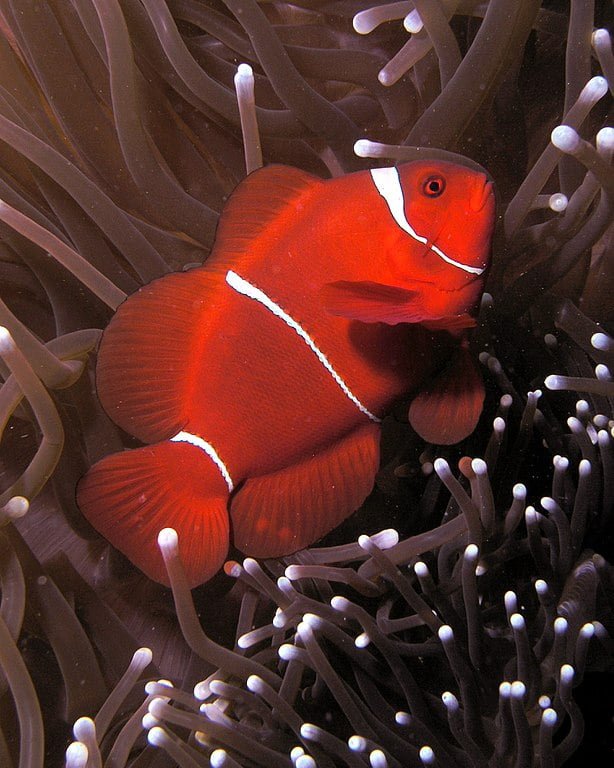
The “Orange Clownfish” species Amphiprion percula is the most famous due to the movie “Finding Nemo” and belongs to the subfamily Amphiprioninae; however, in the ornamental fish industry, the “False Clownfish” species Amphiprion ocellaris is the most well-known and easy to breed and reproduce in aquariums.
To date, 30 species of anemonefish have been recorded, with one species belonging to the genus Premnas, while the rest are in the genus Amphiprion.
Each species of anemonefish has its own distinct color patterns and markings, making them visually stunning additions to any aquarium. In general, these fish, depending on the species, display yellow, orange, reddish, and blackish colorations, with many types showing white bars or patches.
The largest type of clownfish can reach a length of 17 cm, while the smallest species reach only 7-8 cm. There is sexual dimorphism, where females are larger than males.
Understanding the specific requirements and behaviors of each species will help you make an informed decision and ensure a harmonious tank environment.
Habitat of Clownfish
Anemonefish are native to the warm waters of the Pacific and Indian Oceans, including the Red Sea, the Great Barrier Reef, Southeast Asia, Japan, and the Indo-Malaysia region.
In nature, clownfish exhibit fascinating social behaviors and hierarchical structures within their groups. They form strict breeding pairs, with the female being larger and dominant. The male anemonefish is responsible for defending their territory and providing food for the female and their offspring.
Understanding these natural behaviors is crucial for recreating an appropriate environment in your home aquarium.
Anemones and Clownfish
Clownfish have a symbiotic relationship with anemones, which serve as their natural habitat and provide protection against predators. Anemonefish have a unique ability to live among the stinging tentacles of anemones without getting harmed, thanks to a layer of mucus on their skin that protects them from the anemones’ toxins.
Maison and Graham (2016) report that A. percula has a symbiotic association mainly with three species of anemones: Heteractis crispa, H. magnifica, and Stichodactyla gigantea.
The anemones protect the clownfish from predators, while the fish defend the anemones from their predators and parasites. The anemones also obtain nutrients from the fish’s excrement.
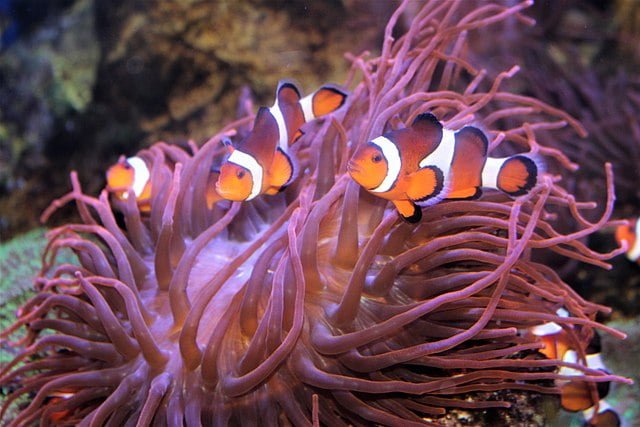
What Do Clownfish Eat?
Providing a balanced diet is essential for the overall health and vitality of your anemonefish. In nature, clownfish have an omnivorous diet, feeding mainly on zooplankton, small crustaceans, and algae. In a home aquarium, if possible, it is important to replicate their natural diet as closely as possible.
A varied diet consisting of high-quality commercial foods such as pellets and flakes, supplemented with frozen and live foods, will ensure your anemonefish receive all the necessary nutrients. It is essential to feed them small amounts multiple times a day, as opposed to one large meal. This mimics their natural feeding habits and helps prevent overfeeding, which can lead to poor water quality.
Additionally, in specialty stores for ornamental fish, you can find artificial diets for your fish. In this regard, Vargas et al., (2019) evaluated the inclusion of insect meal (Hermetia illucens) in the diet of juvenile anemonefish and found no negative effects on growth, stress response, or survival.
On the other hand, Roux et al., (2021) report that the diet for breeding false anemonefish Amphiprion ocellaris should contain high levels of polyunsaturated fatty acids; this diet should include a mix of squid, mussels, shrimp, pellets, and nori algae.
Anemonefish larvae are fed with live prey such as rotifers (Brachionus plicatilis), Artemia nauplii, and the microalgae Nannochloropsis oculata. Regarding this, Nass et al., (2016) recommend offering Artemia nauplii to clownfish larvae (Amphiprion clarkii) two days after hatching.
Finally, Díaz-Jiménez et al., (2021) recommend including a minimum of 0.5% astaxanthin in the diet of Amphiprion ocellaris to maintain intense reddish coloration in the fish.
How Do Clownfish Reproduce?
Breeding clownfish in captivity can be a rewarding experience for aquarium hobbyists. Unlike many other fish species, anemonefish are known for their ability to breed and successfully rear their offspring in home aquariums. The process involves providing an appropriate breeding environment, mimicking natural breeding behaviors, and ensuring proper nutrition for the breeding pair.
A noteworthy feature of anemonefish is that they are protandrous sequential hermaphrodites, meaning they are born male and, when mature, become females. Additionally, the reproductive cycle of clownfish is often correlated with the lunar cycle.
It is important to select a compatible breeding pair and provide them with a designated breeding area, such as a separate tank or a breeding net within the main tank. The female clownfish will lay her eggs on a flat surface or nest built by the male, with a range of 600 to 1500 eggs depending on the size of the female, and the male will fertilize them. The male clownfish will take care of the eggs and remove dead eggs.
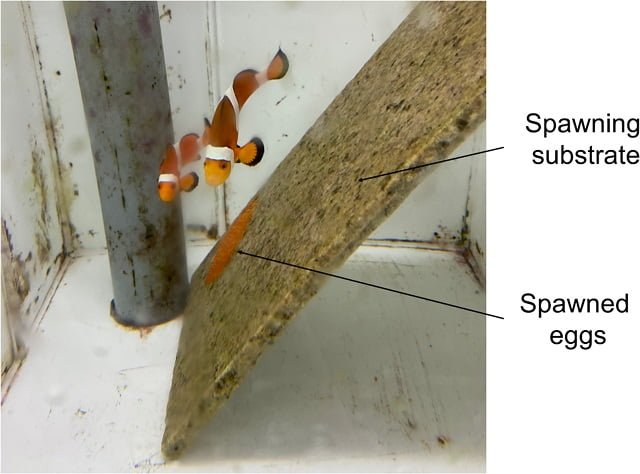
It is important to note that artificial light during the night affects anemonefish reproduction. Fobert et al., (2020) evaluated the exposure of common clownfish to artificial light during the night and found that it reduces reproduction and hatching rate.
The incubation of the eggs lasts between 6 and 10 days. After hatching, the larvae will require specialized care and feeding for approximately 10 to 15 days until they reach the juvenile stage. The study by Roux et al., (2019) offers a detailed description of the life cycle of the false clownfish A. ocellaris, while Roux et al., (2021) describe the larval rearing protocols.
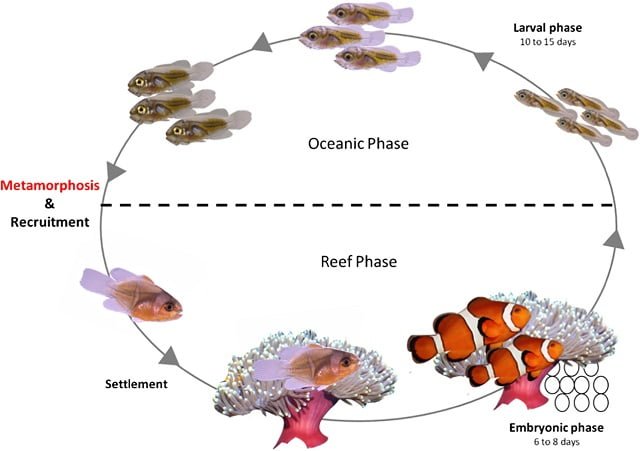
Rodríguez-Ibarra et al. (2024) determined that the optimal water temperature range for rearing Amphiprion ocellaris larvae is between 28 and 30°C. At temperatures below this range, the larvae grow slowly, while higher temperatures increase the likelihood of malformations.
Anemonefish Care
Chambel et al., (2015) report that the optimal stocking density for juvenile percula anemonefish A. percula, for the best condition factor, is 2 fish/L, and they highlighted that a diet with 41% crude protein had the best growth.
The false clownfish Amphiprion ocellaris thrives at an optimal water temperature of 26 oC; however, it can tolerate a temperature range of 22 to 30 oC (Madeira et al., 2016).
On the other hand, Rodrigues et al., (2014) evaluated the mean lethal concentration (LC50) values of non-ionized ammonia (NH3-N) in juvenile garnet clownfish Premnas biaculeatus and determined that the LC50 values of ammonia at 24 and 96 hours were 1.68 and 0.89 mg L−1, respectively. Similarly, Medeiros et al., (2019) recommend avoiding concentrations greater than 0.57 mg/L of ammonia and 25 mg/L of nitrites.
Table 01. Technical Data for Clownfish Rearing
| Parameter | Range |
| Aquarium Size (one female and 4 males) | 70 liters |
| Water Temperature | Range: 22 to 30 oC, Optimal: 26 oC |
| Salinity | 30 – 35 g/L |
| Water pH | 8 – 8.5 |
| Ammonia | <0.57 mg/L |
| Nitrites | < 25 mg/L |
| Photoperiod | 12:12 |
Clownfish Compatibility
Anemonefish are social fish that communicate through clicking sounds. They live in groups with dominant males, a dominant female, and a group of smaller males.
If the female in the group dies, the dominant male anemonefish will permanently change into a female, and the next largest male will become the new dominant male, as reported by the Great Barrier Reef Foundation.
In nature, anemonefish are territorial, aggressively defending their host (anemone) and an area around it, and rarely leaving the protection of their anemone. According to the Aquarium of the Pacific, clownfish aggression includes tail-slapping, chasing, and biting the intruder’s head, abdomen, and fins.
When selecting tank mates for your anemonefish, it is crucial to consider their compatibility and temperament. It is best to choose non-aggressive fish species with similar dietary and environmental requirements.
Some popular tank mates for clownfish include gobies, blennies, and small wrasses. These fish share a similar temperament and can coexist peacefully with clownfish. However, it is essential to introduce new tank mates gradually and closely monitor their interactions to ensure compatibility.
Diseases Affecting Anemonefish
Dhayanithi et al., (2022) report outbreaks of amyloodiniosis in percula clownfish (A. percula) and recommend the use of copper sulfate (10 ppm) to treat amyloodiniosis.
Lymphocystis disease has been reported in A. percula (Lam et al., 2020), A. ocellaris, and A. clarkii (Cheng et al., 2023).
According to Lam et al., (2020), clownfish with lymphocystis present clinical signs such as white spots and warts typically associated with the disease, and they confirmed the identity of a lymphocystis disease virus (LCDV) in anemonefish tissues.
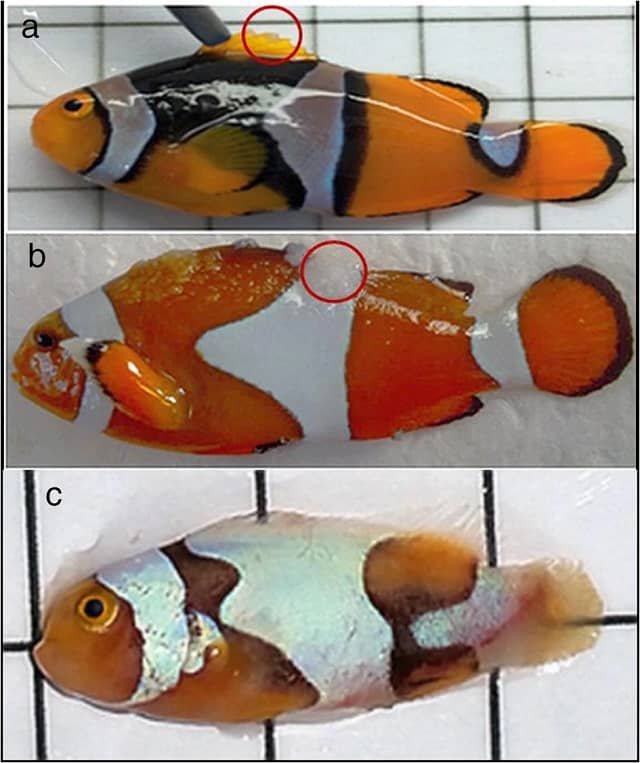
On the other hand, Paixão et al., (2020) recommend probiotic supplementation of Amphiprion ocellaris anemonefish food with the native bacteria Lactobacillus plantarum at 106 CFU/g, as it provides a zootechnical improvement for anemonefish breeding. However, for improving resistance to pathogenic infections by marine bacterium Vibrio fluvialis, 108 CFU/g is the most suitable.
Conclusion
Caring for anemonefish is a rewarding and exciting task that allows you to bring a piece of the ocean into your home. By understanding their unique needs, providing an appropriate habitat, and maintaining optimal water quality, you can create an environment in which your clownfish can thrive and flourish.
From selecting the perfect aquarium setup to ensuring a balanced diet and providing compatible tank mates, this comprehensive guide gives you the knowledge and confidence to embark on a successful journey of clownfish breeding.
So, dive in, explore the wonders of clownfish care, and create an underwater sanctuary that will captivate you and your clownfish companions.
Bibliographic References
Aquarium of the Pacific. Clownfish: Amphiprion ocellaris
Chambel, J., Severiano, V., Baptista, T. et al. Effect of stocking density and different diets on growth of Percula Clownfish, Amphiprion percula (Lacepede, 1802). SpringerPlus 4, 183 (2015). https://doi.org/10.1186/s40064-015-0967-x
Cheng, M.-C.; See, M.S.; Wang, P.-C.; Kuo, Y.-T.; Ho, Y.-S.; Chen, S.-C.; Tsai, M.-A. Lymphocystis Disease Virus Infection in Clownfish Amphiprion ocellaris and Amphiprion clarkii in Taiwan. Animals 2023, 13, 153. https://doi.org/10.3390/ani13010153
Dhayanithi, N.B., Sudhagar, A., Kumar, T.T.A. et al. Study on amyloodiniosis outbreak in captive-bred percula clownfish (Amphiprion percula) and improved control regimens. J Parasit Dis 46, 1103–1109 (2022). https://doi.org/10.1007/s12639-022-01530-1
Díaz-Jiménez, L., Hernández-Vergara, M.P., Pérez-Rostro, C.I. and Olvera-Novoa, M.Á. (2021), The effect of two carotenoid sources, background colour and light spectrum on the body pigmentation of the clownfish Amphiprion ocellaris. Aquaculture Research, 52: 3052-3061. https://doi.org/10.1111/are.15149
Fobert Emily K., Burke da Silva Karen and Swearer Stephen E. 2019. Artificial light at night causes reproductive failure in clownfish. Biol. Lett.152019027220190272
Great Barrier Reef Foundation. Clownfish.
Lam, C., Khairunissa, I., Damayanti, L. et al. Detection of a new strain of lymphocystis disease virus (LCDV) in captive-bred clownfish Amphiprion percula in South Sulawesi, Indonesia. Aquacult Int 28, 2121–2137 (2020). https://doi.org/10.1007/s10499-020-00581-6
Madeira, C., Madeira, D., Diniz, M. S., Cabral, H. N., & Vinagre, C. (2016). Thermal acclimation in clownfish: an integrated biomarker response and multi-tissue experimental approach. Ecological Indicators, 71, 280-292.
Maison, K. A., & Graham, K. S. (2016). Status review report: orange clownfish (Amphiprion percula). NOAA.
Medeiros, R.S., Lopez, B.A., Sampaio, L.A. et al. Ammonia and nitrite toxicity to false clownfish Amphiprion ocellaris . Aquacult Int 24, 985–993 (2016). https://doi.org/10.1007/s10499-015-9965-9
Nass, D.H., Gonçalves, E.L.T. & Tsuzuki, M.Y. Effect of live food transition time on survival, growth and metamorphosis of yellowtail clownfish, Amphiprion clarkii, larvae. Aquacult Int 24, 1255–1261 (2016). https://doi.org/10.1007/s10499-016-9982-3
Paixão, P. E. G., do Couto, M. V. S., da Costa Sousa, N., Abe, H. A., Reis, R. G. A., Dias, J. A. R., … & Fujimoto, R. Y. (2020). Autochthonous bacterium Lactobacillus plantarum as probiotic supplementation for productive performance and sanitary improvements on clownfish Amphiprion ocellaris. Aquaculture, 526, 735395.
Rodrigues, R.V., Romano, L.A., Schwarz, M.H., Delbos, B. and Sampaio, L.A. (2014), Acute tolerance and histopathological effects of ammonia on juvenile maroon clownfish Premnas biaculeatus (Block 1790). Aquac Res, 45: 1133-1139. https://doi.org/10.1111/are.12054
Rodríguez-Ibarra, Luz Estela, Abdo de la Parra, María Isabel, Velasco-Blanco, Gabriela, Aguilar-Zárate, Gabriela, & Martínez-Brown, Juan Manuel. (2024). Effect of temperature on the incubation, growth, survival, and presence of skeletal deformities in larvae of the clownfish Amphiprion ocellaris (Pomacentridae) under rearing conditions. Latin american journal of aquatic research, 52(3), 501-507. https://dx.doi.org/10.3856/vol52-issue3-fulltext-3151
Roux, N., Salis, P., Lambert, A., Logeux, V., Soulat, O., Romans, P., … & Laudet, V. (2019). Staging and normal table of postembryonic development of the clownfish (Amphiprion ocellaris). Developmental Dynamics, 248(7), 545-568.
Roux, N, Logeux, V, Trouillard, N, et al. A star is born again: Methods for larval rearing of an emerging model organism, the False clownfish Amphiprion ocellaris. J Exp Zool (Mol Dev Evol). 2021; 336: 376– 385. https://doi.org/10.1002/jezb.23028
Vargas-Abúndez, A. J., Randazzo, B., Foddai, M., Sanchini, L., Truzzi, C., Giorgini, E., … & Olivotto, I. (2019). Insect meal based diets for clownfish: Biometric, histological, spectroscopic, biochemical and molecular implications. Aquaculture, 498, 1-11.
Yamanaka, S., Okada, Y., Furuta, T., & Kinoshita, M. (2021). Establishment of culture and microinjection methods for false clownfish embryos without parental care. Development, Growth & Differentiation, 63, 459– 466. https://doi.org/10.1111/dgd.12759
Editor at the digital magazine AquaHoy. He holds a degree in Aquaculture Biology from the National University of Santa (UNS) and a Master’s degree in Science and Innovation Management from the Polytechnic University of Valencia, with postgraduate diplomas in Business Innovation and Innovation Management. He possesses extensive experience in the aquaculture and fisheries sector, having led the Fisheries Innovation Unit of the National Program for Innovation in Fisheries and Aquaculture (PNIPA). He has served as a senior consultant in technology watch, an innovation project formulator and advisor, and a lecturer at UNS. He is a member of the Peruvian College of Biologists and was recognized by the World Aquaculture Society (WAS) in 2016 for his contribution to aquaculture.
